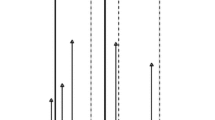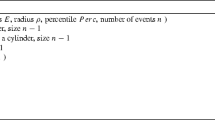Abstract
This study proposes a bootstrap-based space–time surveillance model. Designed to find emerging hotspots in near-real time, the bootstrap based model is characterized by its use of past occurrence information and bootstrap permutations. Many existing space–time surveillance methods, using population at risk data to generate expected values, have resulting hotspots bounded by administrative area units and are of limited use for near-real time applications because of the population data needed. However, this study generates expected values for local hotspots from past occurrences rather than population at risk. Also, bootstrap permutations of previous occurrences are used for significant tests. Consequently, the bootstrap-based model, without the requirement of population at risk data, (1) is free from administrative area restriction, (2) enables more frequent surveillance for continuously updated registry database, and (3) is readily applicable to criminology and epidemiology surveillance. The bootstrap-based model performs better for space–time surveillance than the space–time scan statistic. This is shown by means of simulations and an application to residential crime occurrences in Columbus, OH, year 2000.














Similar content being viewed by others
References
Aldstadt J, Getis A (2006) Using AMOEBA to create a spatial weights matrix and identify spatial clusters. Geogr Anal 38:327–343
Anselin L (1995) Local indicators of spatial association—LISA. Geogr Anal 27:93–115
Besag J, Newell J (1991) The detection of clusters in rare diseases. J R Stat Soc Ser A 154:256–274
Clark PJ, Evans FC (1954) Distances to nearest neighbor as a measure of spatial relationships in populations. Ecology 35:445–453
Cuzick J, Edwards R (1990) Spatial clustering for inhomogeneous populations (with discussion). J R Stat Soc Ser B 52:73–104
Davison AC, Hinkley DV (1997) Bootstrap methods and their application. Cambridge University Press, Cambridge
Efron B, Tibshirani RJ (1993) An introduction to the bootstrap. Chapman & Hall, New York
Elliott P, Wartenberg D (2004) Spatial epidemiology: current approaches and future challenges. Environ Health Perspect 112:998–1006
Farrington CP, Beale AD (1998) The detection of outbreaks of infectious disease. In: Gierl L, Cliff AD, Valleron AJ, Farrington CP, Bull M (eds) GEOMED ’97: proceedings of the international workshop on geomedical systems. Teubner, Verlag, Stuttgart, pp 97–117
Geary RC (1954) The contiguity ratio and statistical mapping. Incorporated Stat 5:115–145
Getis A, Aldstadt J (2004) Constructing the spatial weights matrix using a local statistic. Geogr Anal 36:90–104
Getis A, Ord JK (1992) The analysis of spatial association by use of distance statistics. Geogr Anal 24:189–206
Getis A, Ord JK (1996) Local spatial statistics: an overview. In: Longley P, Batty M (eds) Spatial analysis: modelling in a GIS environment. Geoinformation International, Cambridge, pp 261–277
Griffith DA, Haining R (2006) Beyond mule kicks: the Poisson distribution in geographical analysis. Geogr Anal 38:123–139
Iyengar VS (2005) Space–time clusters with flexible shapes. Morb Mortal Wkly Rep 54:71–76
Jarpe E (1999) Surveillance of the interaction parameter of the Ising model. Commun Stat Theory Methods 28:3009–27
Kleinman K, Abrams A, Yih WK, Platt R, Kulldorff M (2006) Evaluating spatial surveillance: detection of known outbreaks in real data. Stat Med 25:755–69
Knox G (1964) The detection of space–time interactions. Appl Stat 13:25–29
Kulldorff M (1997) A spatial scan statistic. Commun Stat Theory Methods 26:1481–1496
Kulldorff M (2001) Prospective time periodic geographical disease surveillance using a scan statistic. J R Stat Soc Ser A 164:61–72
Kulldorff M, Nagarwalla N (1995) Spatial disease clusters: detection and inference. Stat Med 14:799–810
Kulldorff M, Heffernan R, Hartman J, Assuncao R, Mostashari F (2005) A space–time permutation scan statistic for disease outbreak detection. PLoS Med 2:e59
Kulldorff M, Information Management Services, Inc. (2006) SaTScan v7.0: software for the spatial, temporal, and space-time scan statistics
Lawson AB (1993) On the analysis of mortality events associated with a prespecified fixed point. J R Stat Soc Ser A 156:363–77
Lawson AB (2005) Spatial and spatio-temporal disease analysis. In: Lawson AB, Kleinman K (eds) Spatial and syndromic surveillance. Wiley, Chichester, pp 54–76
Mantel N (1967) The detection of disease clustering and a generalized regression approach. Cancer Res 27:209–220
Miller RG (1981) Simultaneous statistical inference. Springer, New York
Montgomery D (1996) Introduction to statistical quality control. Wiley, New York
Moran PAP (1948) The interpretation of statistical maps. J R Stat Soc Ser B 10:245–51
Openshaw S (1994) Two exploratory space–time-attribute pattern analysers relevant to GIS. In: Fotheringham S, Rogerson P (eds) Spatial analysis and GIS. Taylor & Francis, London, pp 83–104
Openshaw S, Charlton M (1987) A mark 1 Geographical Analysis Machine for the automated analysis of point data-sets. Int J Geogr Inf Syst 1:335–58
Ord JK, Getis A (1995) Local spatial autocorrelation statistics: distributional issues and an application. Geogr Anal 27:286–306
Ratcliffe JH (2001) Policing urban burglary. Trends Issues Crime Crim Justice 213:1–6
Ripley BD (1976) The second-order analysis of stationary point patterns. J Appl Probab 13:255–66
Rogerson P (1997) Surveillance systems for monitoring the development of spatial patterns. Stat Med 16:2081–2093
Rogerson PA (2001a) Monitoring point patterns for the development of space–time clusters. J R Stat Soc A 164:87–96
Rogerson PA (2001b) A statistical method for the detection of geographic clustering. Geogr Anal 33:215–227
Rogerson P (2005) Monitoring spatial maxima. J Geogr Syst 7:101–114
Rogerson P, Sun Y (2001) Spatial monitoring of geographic patterns: an application to crime analysis. Comput Environ Urban Syst 25:539–556
Rogerson PA, Yamada I (2004) Monitoring change in spatial patterns of disease: comparing univariate and multivariate cumulative sum approaches. Stat Med 23:2195–214
Rosenfeld A, Kak (1982) Digital picture processing, vol 2. Academic Press, Orlando
Shaw CR, McKay HD (1942) Juvenile delinquency and urban areas, a study of rates of delinquents in relation to differential characteristics of local communities in American cities. The University of Chicago Press, Chicago
Sherman LW (1995) Hot spots of crime and criminal careers of places. In: JE Eck, Weisburd D (eds) Crime and place. Criminal Justice Press, New York, pp 35–52
Snow J (1857) Cholera, and the water supply in the south district of London. Br Med J 2:864–865
Sonesson C, Bock D (2003) A review and discussion of prospective statistical surveillance in public health. J R Stat Soc A 166:5–21
Stone R (1988) Investigation of excess environmental risks around putative sources: statistical problems and a proposed test. Stat Med 7:649–660
Tango T (1995) A class of tests for detecting "general" and "focused" clustering of rare diseases. Stat Med 14: 2323–2334
Tango T, Takahashi K (2005) A flexibly shaped spatial scan statistic for detecting clusters. Int J Health Geogr 4:11
Thacker SB, Berkelman RL (1988) Public health surveillance in the United States. Epidemiol Rev 10:164–190
Tiefelsdorf M (2000) Modelling spatial processes: the identification and analysis of spatial relationships in regression residuals by means of Moran’s I. Springer, Berlin
Tukey JW (1991) The philosophy of multiple comparisons. Stat Sci 6:100–116
Turnbull BW, Iwano EJ, Burnett WS, Howe HL, Clark LC (1990) Monitoring for clusters of disease: application to leukemia incidence in upstate New York. Am J Epidemiol 312 (Suppl 1):S136–S143
Waller LA, Gotway CA (2004) Applied spatial statistics for public health data. Wiley, New York
Waller LA, Turnbull BW, Clark LC, (1992) Chronic disease surveillance and testing of clustering of disease and exposure: application to leukemia incidence and TCE-contaminated dumpsites in upstate New York. Environmetrics 3:281–300
Westfall PH, Young SS (1989) P-value adjustments for multiple tests in multivariate binomial models. J Am Stat Assoc 84:780–786
Zhang T, Lin G (2006) A supplemental indicator of high-value or low-value spatial clustering. Geogr Anal 38:209–25
Author information
Authors and Affiliations
Corresponding author
Rights and permissions
About this article
Cite this article
Kim, Y., O’Kelly, M. A bootstrap based space–time surveillance model with an application to crime occurrences. J Geograph Syst 10, 141–165 (2008). https://doi.org/10.1007/s10109-008-0058-4
Received:
Accepted:
Published:
Issue Date:
DOI: https://doi.org/10.1007/s10109-008-0058-4




